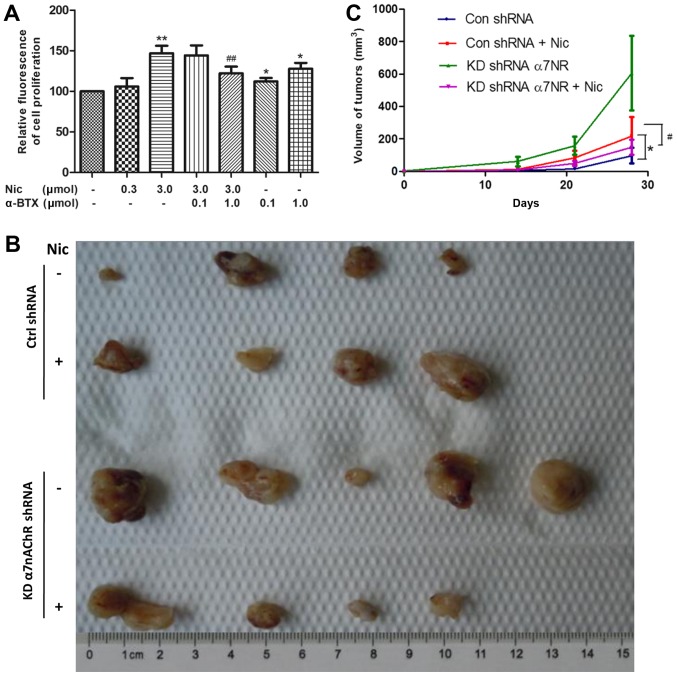Figure 2.
Blocking α7nAChR suppresses nicotine-induced H1299 cell proliferation in vitro and the growth of H1299 tumor xenografts in vivo. (A) H1299 cells were treated with nicotine and/or α-BTX at the indicated concentrations for 48 h, and cell proliferation was assessed by CCK-8 assay. Nicotine (3 µM) significantly promoted H1299 cell proliferation compared with the control, while 1 µM α-BTX obviously attenuated this effect. When cells were treated alone with α-BTX, proliferation was also markedly increased compared with the control group. (B-C) Knockdown of α7nAChR in H1299 cells inhibited the nicotine-stimulated tumor growth of the cell xenografts in nude mice. The nude mice were randomly allocated into four groups: groups one (n=4) and two (n=4) received H1299 cells transfected with Ctrl shRNA, while groups three (n=5) and four (n=4) received H1299 cells transfected with KDα7nAChR shRNA. The same amount of H1299 cells containing Ctrl shRNA or KDα7nAChR shRNA was injected subcutaneously into the right axilla of each nude mouse. Groups two and four received nicotine treatment three times per week at a dose of 1 mg/kg, while groups one and three received the equivalent volume of saline. (B) Images of the formed tumors at the end of 4 weeks of continual growth; tumor volumes were assessed once per week in every mouse. The tumor volumes of group two were obviously greater than those of group one. In tumors consisting of KDα7nAChR-shRNA H1299 cells, nicotine treatment could not induce the tumor to grow larger when compared with tumors consisting of Ctrl-shRNA cells. (C) Tumor volume growth curves revealed that, when stimulated with nicotine, KDα7nAChR-shRNA H1299 tumor xenografts were smaller in volume compared with those of Ctrl-shRNA H1299 cells in nude mice. α7nAChR; α7 nicotinic acetylcholine receptor.

